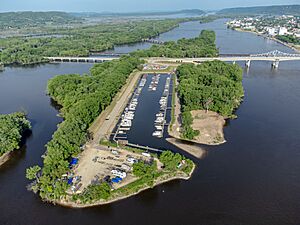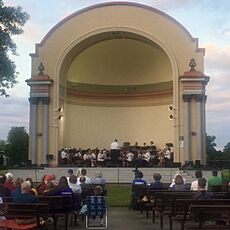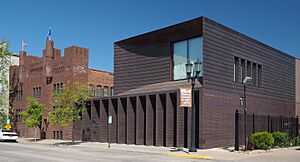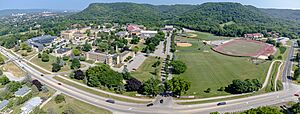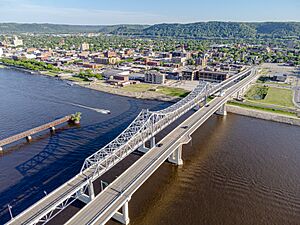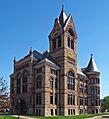Winona, Minnesota facts for kids
Quick facts for kids
Winona, Minnesota
|
|
|---|---|
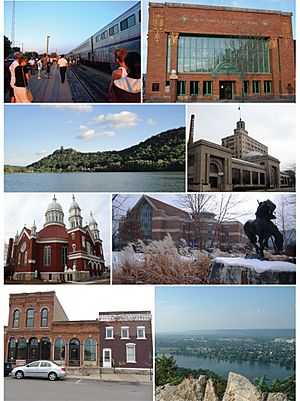
Left-to-right from top-left: the Empire Builder at Winona station, Merchants National Bank, Sugar Loaf, Watkins Incorporated, Basilica of St. Stanislaus, Krueger Library, East Second Street Historic Commercial District, and Garvin Heights City Park.
|
|
| Nickname(s):
The Island City
|
|

|
|
| Country | United States |
| State | Minnesota |
| County | Winona |
| Founded | 1851 |
| Incorporated | March 6, 1857 |
| Government | |
| • Type | Mayor - Council |
| Area | |
| • Total | 24.32 sq mi (62.98 km2) |
| • Land | 19.03 sq mi (49.29 km2) |
| • Water | 5.29 sq mi (13.70 km2) |
| Elevation | 659 ft (201 m) |
| Population
(2020)
|
|
| • Total | 25,948 |
| • Estimate
(2022)
|
25,842 |
| • Density | 1,363.53/sq mi (526.46/km2) |
| Time zone | UTC–6 (Central (CST)) |
| • Summer (DST) | UTC–5 (CDT) |
| ZIP code |
55987
|
| Area code(s) | 507 |
| FIPS code | 27-71032 |
| GNIS feature ID | 2397348 |
Winona (/wɪnˈoʊnə/ win-OH-nə) is a city in and the county seat of Winona County, Minnesota, United States. Located in bluff country on the Mississippi River, its most noticeable physical landmark is Sugar Loaf. The population was 25,948 at the 2020 census.
Contents
History
The site was of the village of Keoxa of Dakota people. The city is named after Winona, a figure in a Sioux legend.
European immigrants settled the area in 1851 and laid out the town into lots in 1852 and 1853. The original settlers were immigrants from New England. The population increased from 815 in December 1855, to 3,000 in December 1856. In 1856, German immigrants arrived as well. The Germans and the Yankees worked together planting trees and building businesses based on lumber, wheat, steamboating and railroads. Between 1859 and 1900, some 5,000 Poles and closely related Kashubians emigrated to Winona, making up one quarter of the population. Since 80% of them were Kashubians, Winona became known as the "Kashubian Capital of America". As a result of the influx of Polish Catholic immigrants, the Church of St. Stanislaus (now Basilica of St. Stanislaus Kostka) was built. For a time, Winona had more millionaires than any other city of its size in the United States.
The railroad and steamboat transportation industries helped Winona grow into a small city that diversified into wheat milling, and lumber production. In 1856, more than 1,300 steamboats stopped at Winona. The Winona and St. Peter Railroad first segment of 11 miles (18 km) from Winona to Stockton, Minnesota was completed by the end of 1862. Winona then had the second operational railroad in Minnesota, after the St. Paul and Pacific Line from Saint Paul to St. Anthony Falls. In December 1870, the Mississippi River was bridged at Winona by the Winona Rail Bridge. In 1892, a wagon toll-bridge over the Mississippi, a steel high-bridge, was completed and remained in service until the opening of the Main Channel Bridge in 1942.
Winona has two historic districts listed on the National Register of Historic Places that combine into a single local historic district administered by the city's Heritage Preservation Commission.
A bandshell was completed in 1924 for outdoor musical performances and events. The Winona Municipal Band holds concerts there during the summer.
Geography
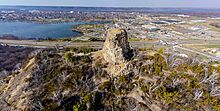
According to the United States Census Bureau, the city has a total area of 24.32 square miles (62.99 km2); 19.03 square miles (49.29 km2) is land and 5.29 square miles (13.70 km2) is water. Lock and Dam 5A spans the Mississippi River in Winona. The highway bridge connecting Winona to the Wisconsin side of the river is at approximately River Mile 726 (USACE map 31).
Winona's primary suburbs are Goodview, Stockton, Minnesota City and Rollingstone to the west, Homer to the southeast and Bluff Siding is 3 miles directly across the interstate bridge to the north and Fountain City to the north. Rochester is 44 miles to the west of Winona, La Crescent is 21 miles to the south, and La Crosse is 30 miles to the southeast.
Winona is part of the driftless area, a region never covered by ice during the last ice age, that includes southeastern Minnesota, northeastern Iowa, southwestern Wisconsin and northwestern Illinois.
Just northeast of the city, connected to Winona via a number of bridges, is Latsch Island. Officially part of the city since 1998, Latsch Island has been home to a unique community of houseboat ("Boathouse") residents for several decades.
The United States Office of Management and Budget has designated Winona as the principal city of the Winona, MN Micropolitan Statistical Area (μSA).
Climate
Winona's weather station records the warmest climate of any in Minnesota, with a normal year-round average (1971–2000) temperature of 48.9 °F (9.4 °C) compared to 43.2 °F (6.2 °C) in Austin to the city's southwest or 45.4 °F (7.4 °C) in Minneapolis, to the northwest, which experiences a strong urban heat island effect. Temperatures are generally very mild by Minnesota standards year-round; the January mean is 17.6 °F (−8.0 °C), while that of July is 75.8 °F (24.3 °C). Winona has a humid continental climate (Dfa) with hot, humid summers and cold, snowy winters.
| Climate data for Winona Dam 5 A, Minnesota (1991–2020 normals, extremes 1893–present) | |||||||||||||
|---|---|---|---|---|---|---|---|---|---|---|---|---|---|
| Month | Jan | Feb | Mar | Apr | May | Jun | Jul | Aug | Sep | Oct | Nov | Dec | Year |
| Record high °F (°C) | 64 (18) |
73 (23) |
88 (31) |
96 (36) |
107 (42) |
106 (41) |
108 (42) |
103 (39) |
102 (39) |
93 (34) |
84 (29) |
66 (19) |
108 (42) |
| Mean maximum °F (°C) | 44.8 (7.1) |
50.2 (10.1) |
65.8 (18.8) |
78.9 (26.1) |
86.9 (30.5) |
92.4 (33.6) |
93.6 (34.2) |
92.0 (33.3) |
87.9 (31.1) |
81.4 (27.4) |
64.1 (17.8) |
49.9 (9.9) |
95.7 (35.4) |
| Mean daily maximum °F (°C) | 25.0 (−3.9) |
30.2 (−1.0) |
42.3 (5.7) |
56.4 (13.6) |
68.7 (20.4) |
78.4 (25.8) |
82.5 (28.1) |
80.6 (27.0) |
73.2 (22.9) |
59.4 (15.2) |
43.5 (6.4) |
30.7 (−0.7) |
55.9 (13.3) |
| Daily mean °F (°C) | 16.5 (−8.6) |
20.7 (−6.3) |
33.0 (0.6) |
46.5 (8.1) |
58.4 (14.7) |
68.5 (20.3) |
72.8 (22.7) |
71.0 (21.7) |
63.4 (17.4) |
50.4 (10.2) |
36.3 (2.4) |
23.5 (−4.7) |
46.7 (8.2) |
| Mean daily minimum °F (°C) | 8.0 (−13.3) |
11.1 (−11.6) |
23.8 (−4.6) |
36.5 (2.5) |
48.0 (8.9) |
58.6 (14.8) |
63.0 (17.2) |
61.4 (16.3) |
53.6 (12.0) |
41.4 (5.2) |
29.2 (−1.6) |
16.3 (−8.7) |
37.6 (3.1) |
| Mean minimum °F (°C) | −15.3 (−26.3) |
−12.1 (−24.5) |
1.3 (−17.1) |
23.4 (−4.8) |
36.0 (2.2) |
46.5 (8.1) |
54.1 (12.3) |
52.3 (11.3) |
40.5 (4.7) |
27.8 (−2.3) |
13.2 (−10.4) |
−6.1 (−21.2) |
−18.9 (−28.3) |
| Record low °F (°C) | −35 (−37) |
−38 (−39) |
−28 (−33) |
4 (−16) |
21 (−6) |
35 (2) |
43 (6) |
33 (1) |
25 (−4) |
7 (−14) |
−11 (−24) |
−31 (−35) |
−38 (−39) |
| Average precipitation inches (mm) | 1.06 (27) |
1.02 (26) |
1.91 (49) |
3.65 (93) |
4.14 (105) |
4.83 (123) |
4.11 (104) |
4.55 (116) |
3.57 (91) |
2.53 (64) |
1.85 (47) |
1.22 (31) |
34.44 (875) |
| Average snowfall inches (cm) | 9.8 (25) |
9.3 (24) |
5.7 (14) |
1.6 (4.1) |
0.2 (0.51) |
0.0 (0.0) |
0.0 (0.0) |
0.0 (0.0) |
0.0 (0.0) |
0.1 (0.25) |
1.4 (3.6) |
9.5 (24) |
37.6 (96) |
| Average extreme snow depth inches (cm) | 9.6 (24) |
11.4 (29) |
7.7 (20) |
1.1 (2.8) |
0.2 (0.51) |
0.0 (0.0) |
0.0 (0.0) |
0.0 (0.0) |
0.0 (0.0) |
0.0 (0.0) |
1.0 (2.5) |
7.1 (18) |
14.1 (36) |
| Average precipitation days (≥ 0.01 in) | 8.6 | 7.6 | 9.0 | 11.8 | 13.0 | 12.2 | 10.1 | 9.4 | 9.5 | 9.6 | 7.5 | 9.0 | 117.3 |
| Average snowy days (≥ 0.1 in) | 5.3 | 4.4 | 2.3 | 0.7 | 0.0 | 0.0 | 0.0 | 0.0 | 0.0 | 0.1 | 1.1 | 4.7 | 18.6 |
| Source: NOAA | |||||||||||||
Demographics
| Historical population | |||
|---|---|---|---|
| Census | Pop. | %± | |
| 1860 | 2,464 | — | |
| 1870 | 7,192 | 191.9% | |
| 1880 | 10,208 | 41.9% | |
| 1890 | 18,208 | 78.4% | |
| 1900 | 19,714 | 8.3% | |
| 1910 | 18,583 | −5.7% | |
| 1920 | 19,143 | 3.0% | |
| 1930 | 20,850 | 8.9% | |
| 1940 | 22,490 | 7.9% | |
| 1950 | 25,031 | 11.3% | |
| 1960 | 24,895 | −0.5% | |
| 1970 | 26,438 | 6.2% | |
| 1980 | 25,075 | −5.2% | |
| 1990 | 25,399 | 1.3% | |
| 2000 | 27,069 | 6.6% | |
| 2010 | 27,592 | 1.9% | |
| 2020 | 25,948 | −6.0% | |
| 2022 (est.) | 25,842 | −6.3% | |
| U.S. Decennial Census 2020 Census |
|||
2020 census
As of the census of 2020, the population was 25,948. The population density was 1,363.5 inhabitants per square mile (526.5/km2). There were 11,525 housing units at an average density of 605.6 per square mile (233.8/km2). The racial makeup of the city was 89.3% White, 2.8% Black or African American, 2.2% Asian, 0.3% Native American, 1.3% from other races, and 4.2% from two or more races. Ethnically, the population was 3.2% Hispanic or Latino of any race.
2010 census
As of the census of 2010, there were 27,592 people, 10,449 households, and 5,022 families residing in the city. The population density was 1,464.5 inhabitants per square mile (565.4/km2). There were 10,989 housing units at an average density of 583.3 per square mile (225.2/km2). The racial makeup of the city was 93.0% White, 1.9% African American, 0.3% Native American, 2.9% Asian, 0.5% from other races, and 1.3% from two or more races. Hispanic or Latino of any race were 1.7% of the population.
There were 10,449 households, of which 20.7% had children under the age of 18 living with them, 36.4% were married couples living together, 8.5% had a female householder with no husband present, 3.2% had a male householder with no wife present, and 51.9% were non-families. 35.6% of all households were made up of individuals, and 12.6% had someone living alone who was 65 years of age or older. The average household size was 2.24 and the average family size was 2.84.
The median age in the city was 26.7 years. 14.4% of residents were under the age of 18; 33.2% were between the ages of 18 and 24; 18.5% were from 25 to 44; 20.5% were from 45 to 64; and 13.3% were 65 years of age or older. The gender makeup of the city was 47.3% male and 52.7% female.
Economy
Winona is home to the headquarters to many companies including Fastenal, Thern Inc., Knitcraft Corporation, RTP Company, We-No-Nah Canoe, United Building Centers, Badger Equipment Company, Winona Lighting, Hal Leonard Music, WinCraft Sports, and Winona Pattern & Mold. Bay State Milling operates a grain processing facility in Winona and was founded there in 1899.
Watkins Incorporated, a manufacturer of health remedies, baking products, and household goods, was founded in 1868 by J.R. Watkins in Plainview, Minnesota. The company relocated to Winona in 1885. By the early 20th century, J.R. Watkins had become one of the largest direct-sales companies in the United States. The company headquarters, a complex of seven buildings, is listed on the National Register of Historic Places.
Winona is also known as the stained glass capital of the United States. Willet Hauser Architectural Glass, Inc is a North American stained glass firm located in Winona, Minnesota that specializes in the design, fabrication, preservation and restoration of leaded stained glass and faceted glass windows. The studio is one of the oldest in North America.
Fastenal, headquartered in Winona., ranked number 479 in the 2021 Fortune 500 based on its 2020 revenues. In 2023 Fastenal fell to number 514. https://tcbmag.com/minnesota-now-has-15-fortune-500-companies/ Its stock is a component of the Nasdaq 100 index.
Top employers
According to the City's 2022 Comprehensive Annual Financial Report, the largest employers in the city are:
| # | Employer | Type of Business | # of Employees | Percentage |
|---|---|---|---|---|
| 1 | Fastenal Company | Commercial/Industrial | 1,618 | 5.00% |
| 2 | Winona State University | Post-secondary education | 1,050 | 4.19% |
| 3 | Winona Health | Hospital/Clinic/Health Care | 975 | 3.59% |
| 4 | Winona Area Public Schools ISD 861 | K-12 education | 684 | 2.20% |
| 5 | WinCraft | Promotional materials | 500 | 1.75% |
| 6 | Saint Mary's University of Minnesota | Post-secondary education | 450 | 1.57% |
| 7 | TRW Automotive Electronics | Industrial machinery | 400 | 1.40% |
| 8 | RTP Company | Industrial | 375 | 1.31% |
| 9 | County of Winona | County Government | 300 | 1.05% |
| 10 | Watlow Electric Manufacturing Company | Electronic Control manufacturer | 289 | 1.01% |
| — | Total principal employers | — | 6,606 | 23.07% |
| — | Other employers | — | 22,019 | 76.93% |
| — | Total employers | — | 28,625 | 100.00% |
Arts and culture
Architecture
In addition to the two NRHP historic districts, Winona has multiple buildings of architectural significance
- Choate Department Store
- Merchants National Bank Building
- Watkins Incorporated Building
- Winona Savings Bank Building
- Winona Commercial Historic District
- East Second Street Commercial Historic District
Culture
The city offers artistic venues and historical experiences. The city earned the nickname "Stained Glass Capital of the United States" for its stunning religious and secular stained glass pieces. The Great River Shakespeare Festival stages professional productions of Shakespeare's plays each summer, while the Minnesota Conservatory for the Arts provides a full spectrum of artistic training and performances. The River Arts Alliance organizes educational programs, community events, and public art projects while fostering a collaborative artist community. Projects include poetry etched into sidewalks on the Winona Poetry Walk. The Winona County History Center, made up of two buildings, the historic Winona Armory and the modern Laird Norton Addition, offers exhibits in its museum and art gallery, and exploration of the region's history in their Laird Lucas Library and Archives.
Landmarks
- Sugar Loaf is river bluff topped by a distinctive rock pinnacle, which was left after quarrying activity in the 19th century. It is located at the junction of Highway 61 and Highway 43/Mankato Avenue.
- Basilica of Saint Stanislaus Kostka is a historic Catholic church built in 1895 in the Polish Cathedral Style.
- Lake Winona is separated from the Mississippi River by downtown Winona. It is surrounded by a park, which contains the Winona Lake Park Bandshell and a recreation center.
- Garvin Heights City Park is an overlook of the Mississippi River that is used to view a panorama of the city and surrounding area.
- Merchants National Bank by Purcell and Elmslie is a bank building designed in the Prairie School architectural style. It was built in 1912 and features elaborate terracotta and stained-glass ornamentation.
Education
Winona became the site of the first normal school west of the Mississippi in 1858 with the establishment of Winona Normal School (now Winona State University). This was the beginning of Winona's tradition as a center of higher education. In 2018-2019, Winona State University (WSU) had approximately 7,200 undergraduate students and 560 graduate students. WSU is part of the Minnesota State college system.
Saint Mary's College (now Saint Mary's University) was founded as a private Catholic, Lasallian school in 1912. Later, as the necessary opportunity of higher education for women became apparent, the College of Saint Teresa was created. After Saint Mary's became co-ed in 1969, Saint Teresa closed down in 1988, and its facilities are now used, owned, and/or operated by Saint Mary's University of Minnesota, Winona State University, and Cotter High School. Minnesota State College Southeast also has a campus in Winona.
There is a diverse variety of K-12 educational opportunities. Run by Independent School District 861, the local public school system includes five elementary schools (three in the city of Winona), the Winona Middle School, and the Winona Senior High School. The Winona Area Catholic Schools system includes St. Nicholas Hall Primary School, St. Luke Elementary School, Cotter Junior High School, and Cotter Senior High School. St. Martin's School, St. Matthew's School, and Hope Lutheran High School are private Lutheran schools in Winona. Two charter schools, Winona Riverway Learning Community (PreK-12) l, and Bluffview Montessori Charter School (K-8) are located in the city. Bluffview is notable as the first charter Montessori and the second charter school overall in the United States.
Main Square Montessori (MSM) is a nonprofit Montessori learning center for children from the ages of 16 months to six years old in a partnership between the Hiawatha Education Foundation and Cotter Schools.
Several organizations also provide community education. The Minnesota Conservatory for the Arts offers community classes for early childhood through 55+ adult programs in the areas of dance, music, theater, and visual arts. Winona Area Public Schools, Winona State University, The City of Winona Parks and Recreation, and Winona Arts Center offer additional community learning opportunities.
Media
Winona has two newspapers: the Winona Daily News, a daily morning paper; and the Winona Post, a weekly paper with a Wednesday edition.
Television
Winona receives TV signals from neighboring cities, including several channels each from La Crosse, Rochester, Eau Claire, and the Twin Cities, although what can be received depends on the location within the area, as the extensive system of valleys and ridges may block any or all signals. There is one local public broadcasting TV network, HBCI, which is available only to subscribers of the HBC cable company.
Radio
FM
| FM radio stations | ||||
|---|---|---|---|---|
| Frequency | Call sign | Name | Format | Owner |
| 88.5 FM | K203BR (KFSI Translator) |
Christian | Faith Sound Incorporated | |
| 89.5 FM | KQAL | College | Winona State University | |
| 92.5 FM | KSMR | Christian | Real Presence Radio | |
| 94.3 FM | K232CZ (KSMR Translator) |
|||
| 95.3 FM | KGSL | KG-95.3 | Hot AC | Leighton Broadcasting |
| 98.7 FM | W274BW (KWNO-AM Translator) |
News/Talk | ||
| 99.3 FM | KWMN | Winona Sports Network | Sports | |
| 101.1 FM | KRIV | 101.1 The River | Classic Hits | |
| 101.9 FM | K270AB (KZSE Translator) |
MPR News | Public Radio | Minnesota Public Radio |
| 103.9 FM | K280EL (KQYB Translator) |
KQ98 | Country | Family Radio, Inc. |
| 107.3 FM | W297AW (KLSE Translator) |
Classical MPR | Classical | Minnesota Public Radio |
AM
| AM radio stations | ||||
|---|---|---|---|---|
| Frequency | Call sign | Name | Format | Owner |
| 1230 AM | KWNO | News/Talk | Leighton Broadcasting | |
| 1380 AM | KHWK | Country | ||
Infrastructure
Transportation
U.S. Highway 14, U.S. Highway 61, Minnesota Highway 43 and Wisconsin State Highway 54 are the main routes into the city. Interstate Highway 90 is located a short distance south of the city.
Winona was once served by four railroads; Milwaukee Road, Chicago & North Western, Chicago Great Western and Green Bay & Western, with the Burlington Route trains stopping at a station across the river in Wisconsin. Only the former Milwaukee Road station remains and is now served by Amtrak's Empire Builder daily in each direction between Chicago and Seattle and Portland. As well as the daily Borealis running between Saint Paul, Minnesota and Chicago. The Milwaukee Road is now owned by Canadian Pacific, as is the Dakota, Minnesota & Eastern, which operates the former Chicago & North Western line from Winona to the west.
The Winona Transit Service provides public bus transportation six days per week. The city is also located along the Mississippi River Trail, and the Flyway Trail connects the city to nearby trail systems in Wisconsin. Winona Municipal Airport - Max Conrad Field serves general aviation in the area. It was once served by one passenger airliner, Mississippi Valley Airlines until the mid-1970s.
Notable people
- Carol Bartz, former CEO of Yahoo!, formerly of Autodesk
- Charles H. Berry, first Attorney General of Minnesota
- Bernhard Brenner, founder/president of Knitcraft Corporation, manufacturer of St. Croix luxury knitwear
- Paul Breza, Roman Catholic priest and founder of Winona's Polish Cultural Institute and Museum
- Robert Henry Brom, Roman Catholic bishop
- Alec Brown, NBA player
- Roger Busdicker, co-founder of Hal Leonard Corporation
- Jan Romuald Byzewski OFM, pastor of Saint Stanislaus Kostka Parish and founder of the Polish-language newspaper Wiarus
- Tracy Caulkins, swimmer, three-time Olympic gold medalist
- Max Conrad, aviator
- James Earle Fraser (1876–1953), sculptor, designer of the Buffalo Nickel and the "End of the Trail" statue
- Paul Giel, athlete, two-time Big Ten Player of the Year, member of College Football Hall of Fame
- Mabel Farrington Gifford, expert on speech defects and disorders
- Elliott Heath, distance runner
- Garrett Heath, distance runner
- James "J. R." Keller, state senator and representative
- Bob Kierlin, businessman and politician
- Alphonse Roy Lejk, politician
- John G. McMynn, Wisconsin Superintendent of Public Instruction
- William D. Mitchell, United States Attorney General under presidents Calvin Coolidge and Herbert Hoover
- Thomas H. Moodie, North Dakota governor
- Anne Pellowski, author, educator, and Kashubian American activist
- Benjamin H. Randall, American politician and businessman, early settler to Minnesota Territory
- Winona Ryder, actress, born in Winona and named after the city
- Corey Schell, American professional bowhunter and archer
- Charles Peter Schuler, Minnesota state legislator and businessman
- Orlando Stevens, member of the state legislatures of Vermont and Minnesota
- Tom Stoa, Minnesota state legislator and beekeeper
- Eleanor Joy Toll, Los Angeles-area educator and clubwoman
- Joseph Ray Watkins, entrepreneur and founder of Watkins Incorporated
- Julie Wera, infielder with 1927 New York Yankees
- Eugenia Wheeler Goff (1844-1922), historian, cartographer, educator, and author
- William Windom (1827–1891), member of both the U.S. House of Representatives and U.S. Senate from Minnesota; later Secretary of the Treasury
- Cat Zingano, mixed martial artist
Sister cities
 Bytów, Pomeranian Voivodeship, Poland
Bytów, Pomeranian Voivodeship, Poland Misato, Miyagi, Japan
Misato, Miyagi, Japan
Gallery
See also
 In Spanish: Winona (Minnesota) para niños
In Spanish: Winona (Minnesota) para niños




